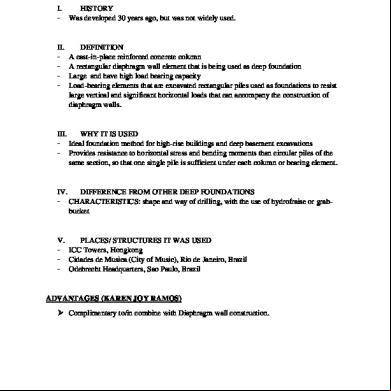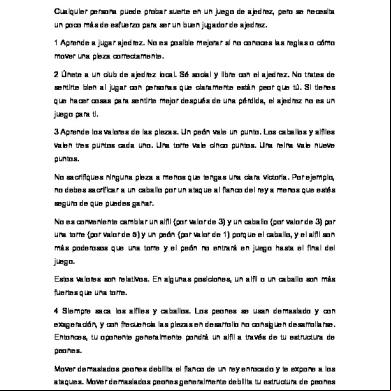Bridge Report Barrette Piles e4n4w
This document was ed by and they confirmed that they have the permission to share it. If you are author or own the copyright of this book, please report to us by using this report form. Report 2z6p3t
Overview 5o1f4z
& View Bridge Report Barrette Piles as PDF for free.
More details 6z3438
- Words: 916
- Pages: 4
INTRODUCTION (ARIES ALTEZA) I. HISTORY - Was developed 30 years ago, but was not widely used.
II. -
DEFINITION A cast-in-place reinforced concrete column A rectangular diaphragm wall element that is being used as deep foundation Large and have high load bearing capacity Load-bearing elements that are excavated rectangular piles used as foundations to resist large vertical and significant horizontal loads that can accompany the construction of diaphragm walls.
III. WHY IT IS USED - Ideal foundation method for high-rise buildings and deep basement excavations - Provides resistance to horizontal stress and bending moments than circular piles of the same section, so that one single pile is sufficient under each column or bearing element.
IV. DIFFERENCE FROM OTHER DEEP FOUNDATIONS - CHARACTERISTICS: shape and way of drilling, with the use of hydrofraise or grabbucket
V. PLACES/ STRUCTURES IT WAS USED - ICC Towers, Hongkong - Cidades de Musica (City of Music), Rio de Janeiro, Brazil - Odebrecht Headquarters, Sao Paulo, Brazil
ADVANTAGES (KAREN JOY RAMOS) Complimentary to/in combine with Diaphragm wall construction.
Due to their massive size, barrettes facilitate “top down” construction. o This is achieved by extending the barrette to ground surface level or, if the barrette sections are considered too large in the context of parking arrangements, plunge columns of smaller section can be placed into the barrettes. Concrete backfilling can be terminated at any depth o The execution of non-concreted lengths is possible. Very high bearing capacity. o At great installation depths, barrettes resist large concentrated vertical loads; they carry off significant horizontal stress and bending moments better than circular piles of the same section so that one single pile is sufficient under each column or bearing element
The bottom of the excavation can penetrate resistant or rocky soil layers to accommodate high loadings. Low environmental impact during the works – only moderate noise, no vibration during construction.
Fast execution and optimized construction costs, since the same element can be used as a ing wall (Diaphragm wall), a cut-off wall and a deep foundation element. Can be constructed close to existing buildings. o A clearance of about 30 cm from the outer walls of buildings must be observed. Can be constructed in a very wide range of soil types.
ENVIRONMENTAL IMPACTS (RICCA MAE R. PARAS) 1. Vibration-free execution Construction often generates community noise/vibration complaints, even when it takes place over a limited time frame. In recent years, public concerns about construction noise and vibration have increased significantly, due partly to lengthy periods of heavy construction on some “mega-projects” and also to the increasing prevalence of nighttime construction that is undertaken to avoid disrupting workday road and rail traffic. Noise and vibration complaints typically arise from interference with people's activities, especially when the adjacent community has no clear understanding of the extent or duration of the construction. Misunderstandings can arise when the contractor is considered to be insensitive by the community, even though the contractor believes the work is being performed in compliance with local ordinances. This situation underscores the need for early identification and assessment of potential problem areas. 2. Removal of soil and disposal of bentonite Bentonite is an absorbent clay that has aluminum properties and is formed out of volcanic ash. While commonly found in beauty products to absorb high amounts of oil in the skin, bentonite is also often used in large quantities in various drilling and construction applications. This form of bentonite, when it is liquefied into slurry, must be disposed of
3.
4.
carefully and properly to avoid compromising the safety of the people who may be exposed to it. Low noise pollution On construction worksites there are many different noise sources and these sources exhibit many differing types of noise such as background noise, idling noise, blast noise, impact noise, rotating noise, intermittent noise, howling, screeches and squeals that need to be controlled Removal of debris, demolition of old foundations and backfill with stabilized sand Cement stabilized sand creates an economical alternative to standard bases for paved surfaces such as roads and parking areas. Cement stabilized sand is widely available and cost-efficient; it utilizes less cement for a surface area while maintaining its durability.
TECHNICAL SPECIFICATION (JOHN JOSEPH R. AUSTRIA) A barrette is a pile that excavated using grabs and chisels through a thixotropic suspension of bentonite or other agent which the side shafts as excavation proceeds, and which is concreted in one continuous operation. Excavation for Barrettes 1. Excavation of barrettes shall be carried out by mechanical methods. Blasting shall not be used unless permitted by the Engineer. 2. The stability of excavations for barrettes shall be maintained by a thixotropic slurry containing bentonite agent. 3. The height of guide walls for barrettes shall be such that the head of slurry is sufficient to ensure the stability of excavations and that excessive movements of the adjacent ground will not occur.
The excavation of barrettes under the protection of a bentonite suspension occurs by means of various tools, chosen in relation to the nature of the soil: hydrofraise, mechanical or hydraulic grab. Length to be determined by reference to the body of the grab (2.85 m or 3.40 m) and on the basis of the trench stability calculation (depending on the groundwater level, the grain size distribution of the soil, the proximity of loads, the type of the bentonite)
Allowable bearing capacity from 5.000 kN upwards to 50.000 kN
II. -
DEFINITION A cast-in-place reinforced concrete column A rectangular diaphragm wall element that is being used as deep foundation Large and have high load bearing capacity Load-bearing elements that are excavated rectangular piles used as foundations to resist large vertical and significant horizontal loads that can accompany the construction of diaphragm walls.
III. WHY IT IS USED - Ideal foundation method for high-rise buildings and deep basement excavations - Provides resistance to horizontal stress and bending moments than circular piles of the same section, so that one single pile is sufficient under each column or bearing element.
IV. DIFFERENCE FROM OTHER DEEP FOUNDATIONS - CHARACTERISTICS: shape and way of drilling, with the use of hydrofraise or grabbucket
V. PLACES/ STRUCTURES IT WAS USED - ICC Towers, Hongkong - Cidades de Musica (City of Music), Rio de Janeiro, Brazil - Odebrecht Headquarters, Sao Paulo, Brazil
ADVANTAGES (KAREN JOY RAMOS) Complimentary to/in combine with Diaphragm wall construction.
Due to their massive size, barrettes facilitate “top down” construction. o This is achieved by extending the barrette to ground surface level or, if the barrette sections are considered too large in the context of parking arrangements, plunge columns of smaller section can be placed into the barrettes. Concrete backfilling can be terminated at any depth o The execution of non-concreted lengths is possible. Very high bearing capacity. o At great installation depths, barrettes resist large concentrated vertical loads; they carry off significant horizontal stress and bending moments better than circular piles of the same section so that one single pile is sufficient under each column or bearing element
The bottom of the excavation can penetrate resistant or rocky soil layers to accommodate high loadings. Low environmental impact during the works – only moderate noise, no vibration during construction.
Fast execution and optimized construction costs, since the same element can be used as a ing wall (Diaphragm wall), a cut-off wall and a deep foundation element. Can be constructed close to existing buildings. o A clearance of about 30 cm from the outer walls of buildings must be observed. Can be constructed in a very wide range of soil types.
ENVIRONMENTAL IMPACTS (RICCA MAE R. PARAS) 1. Vibration-free execution Construction often generates community noise/vibration complaints, even when it takes place over a limited time frame. In recent years, public concerns about construction noise and vibration have increased significantly, due partly to lengthy periods of heavy construction on some “mega-projects” and also to the increasing prevalence of nighttime construction that is undertaken to avoid disrupting workday road and rail traffic. Noise and vibration complaints typically arise from interference with people's activities, especially when the adjacent community has no clear understanding of the extent or duration of the construction. Misunderstandings can arise when the contractor is considered to be insensitive by the community, even though the contractor believes the work is being performed in compliance with local ordinances. This situation underscores the need for early identification and assessment of potential problem areas. 2. Removal of soil and disposal of bentonite Bentonite is an absorbent clay that has aluminum properties and is formed out of volcanic ash. While commonly found in beauty products to absorb high amounts of oil in the skin, bentonite is also often used in large quantities in various drilling and construction applications. This form of bentonite, when it is liquefied into slurry, must be disposed of
3.
4.
carefully and properly to avoid compromising the safety of the people who may be exposed to it. Low noise pollution On construction worksites there are many different noise sources and these sources exhibit many differing types of noise such as background noise, idling noise, blast noise, impact noise, rotating noise, intermittent noise, howling, screeches and squeals that need to be controlled Removal of debris, demolition of old foundations and backfill with stabilized sand Cement stabilized sand creates an economical alternative to standard bases for paved surfaces such as roads and parking areas. Cement stabilized sand is widely available and cost-efficient; it utilizes less cement for a surface area while maintaining its durability.
TECHNICAL SPECIFICATION (JOHN JOSEPH R. AUSTRIA) A barrette is a pile that excavated using grabs and chisels through a thixotropic suspension of bentonite or other agent which the side shafts as excavation proceeds, and which is concreted in one continuous operation. Excavation for Barrettes 1. Excavation of barrettes shall be carried out by mechanical methods. Blasting shall not be used unless permitted by the Engineer. 2. The stability of excavations for barrettes shall be maintained by a thixotropic slurry containing bentonite agent. 3. The height of guide walls for barrettes shall be such that the head of slurry is sufficient to ensure the stability of excavations and that excessive movements of the adjacent ground will not occur.
The excavation of barrettes under the protection of a bentonite suspension occurs by means of various tools, chosen in relation to the nature of the soil: hydrofraise, mechanical or hydraulic grab. Length to be determined by reference to the body of the grab (2.85 m or 3.40 m) and on the basis of the trench stability calculation (depending on the groundwater level, the grain size distribution of the soil, the proximity of loads, the type of the bentonite)
Allowable bearing capacity from 5.000 kN upwards to 50.000 kN










